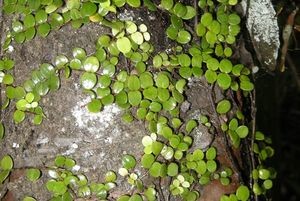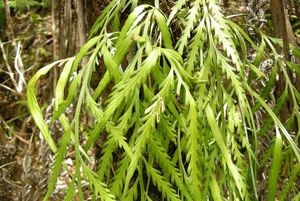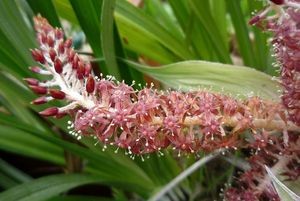 Metrosideros perforata. Photo: John Sawyer.Epiphytic plants are those that are found growing on another plant or object but are not parasitic as they derive their moisture and nutrients from their surrounding environment. All major plant groups include species that can behave epiphytically. In temperate regions of the world epiphytes are often liverworts, lichens or mosses whereas in the tropics they are more usually bromeliads, orchids and cacti. The term epiphytic comes from the Greek epi- (upon) and phyton (plant).
Metrosideros perforata. Photo: John Sawyer.Epiphytic plants are those that are found growing on another plant or object but are not parasitic as they derive their moisture and nutrients from their surrounding environment. All major plant groups include species that can behave epiphytically. In temperate regions of the world epiphytes are often liverworts, lichens or mosses whereas in the tropics they are more usually bromeliads, orchids and cacti. The term epiphytic comes from the Greek epi- (upon) and phyton (plant).
 Asplenium flaccidum at Butterfly Creek. Photo: John SawyerFor more information about New Zealand’s vascular plant epiphytes including typical, occasional, hemi- and ephemeral epiphytes, follow this link below.
Asplenium flaccidum at Butterfly Creek. Photo: John SawyerFor more information about New Zealand’s vascular plant epiphytes including typical, occasional, hemi- and ephemeral epiphytes, follow this link below.
W.R.B. Oliver, in a paper on New Zealand Epiphytes in 1930, recognised 48 species of typically epiphytic vascular plant (link to full reference below). Oliver also recognised several other groups of epiphyte including those that are ephemeral (20), hemi- or taproot epiphytes (10) and some that are only epiphytic occasionally (11). He then classified epiphytes into three main groups based on their water relations:
- Epiphytes with no special means of protection against evaporation
- Epiphytes with the epigeal parts protected
- Epiphytes with special devices for absorbing and retaining water
 Astelia solandri. Photo: Jesse Bythell.In New Zealand there are a number of common epiphytes that are regularly seen during forest walks including:
Astelia solandri. Photo: Jesse Bythell.In New Zealand there are a number of common epiphytes that are regularly seen during forest walks including:
- Metrosideros robusta (northern rata)
- Earina mucronata
- Earina autumnalis
- Asplenium flaccidum
- Griselinia lucida
For more information see:
- Vegetative features of Griselinia lucida by John Dawson
- Epiphytic orchids (NZ Native Orchid website)
- The Epipytic Orchids of New Zealand by Edwin D. Hatch (Transactions and Proceedings of the Royal Society. Vol. 78, 1950)
- Epiphyte (Wikipedia)
- New Zealand Epiphytes by W.R.B. Oliver - Journal of Ecology, Vol. 18, No. 1 (Aug., 1930), pp. 1-50
